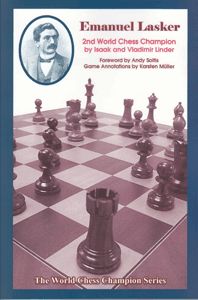Emanuel Lasker
Second World Chess Champion
Isaak Linder, Vladimir Linder

The symbol REI stands for Recreational Equipment Incorporated for most Americans, but ask a chess player and you will get the answer Russell Enterprises Incorporated. Founded in 1986 by Hanon Russell, REI publishes books on all aspects of the game from openings to endings, from training books to game collections. Its latest offerings from 2010 reflect this diversity.
EMANUEL LASKER: 2ND WORLD CHESS CHAMPION by the famous father and son team of Isaak and Vladimir Linder is a substantial work on the man who occupied Caissas throne for 27 years. While Lasker has always been recognized as one of the greatest of the great, less than a decade ago English reading chess players wishing to learn more about his life and games had few books to choose from. DR. LASKERS CHESS CAREER (Part 1, 1889-1914) by Reinfeld and Fine, EMANUEL LASKER: THE LIFE OF A CHESS MASTER by Dr. Hannak, and specialist material by Gilchrist and Whyld were the only works devoted purely to his career with the sections on Lasker in Kasparovs MY GREAT PREDECESSORS and Crouchs HOW TO DEFEND IN CHESS well worth checking out.
The situation changed dramatically with the publication of WHY LASKER MATTERS by GM Andrew Soltis in 2005, which offered 100 carefully annotated games spanning Laskers career from 1889 to 1936. Soltis not only offered modern annotations to the games, he also challenged many of the standard Lasker observations such as the notion that he intentionally made inferior moves in hopes of his goading his opponents into rash action.
EMANUEL LASKER, SECOND WORLD CHESS CHAMPION is a fine complementary work to that by Soltis. Based in part on the Linders 2001 Russian language work THE KINGS OF CHESS, this potpourri of all things Lasker offers the readers a little of this and a little of that. The beginning of the book features the first significant English language biographical examination of Laskers career in over fifty years, tracking a chess vagabond who spent substantial periods of his life living in the United States and Russia.
Adding to the Linders work, this volume includes over fifty of Laskers games and fragments annotated by German GM Karsten Müller who took care to avoid overlapping (except in the most famous cases) with those appearing in WHY LASKER MATTERS. The Linders also have extensive chapters on Laskers contributions to chess theory, his literary accomplishments and his role in chess history. A Foreword by Andy Soltis, photographs, crosstables and detailed indexes round out this interesting book that will meet the needs of all but the keenest of Lasker fans. Those thirsting for more will have to learn German to tackle the mammoth (1079 pages) EMANUEL LASKER: DENKER WELTENBÜRGER SCHACHWELTMEISTER, which includes Victor Kortchnoi and Robert Hübner among its many contributors.
